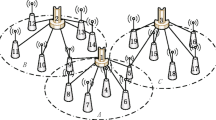Abstract
Spatial reuse TDMA has been proposed as an access scheme for multi-hop radio networks where real-time service guarantees are important. The idea is to increase capacity by letting several radio terminals use the same time slot when possible. A time slot can be shared when the radio units are geographically separated such that small interference is obtained. In reuse scheduling, there are several alternative assignment methods. Traditionally, transmission rights are given to nodes or to links, i.e., transmitter/receiver pairs. We present a comparison of these two approaches and show that both have undesirable properties in certain cases, e.g. link assignment gives a higher delay for low traffic loads but can achieve much higher throughput than node assignment. Furthermore, we propose a novel assignment strategy, achieving the advantages of both methods. Simulation results show that the proposed method can achieve the throughput of link assignment for high traffic loads as well as the lower delay characteristics of node assignment for low traffic loads.
Similar content being viewed by others
References
E. Arikan, Some complexity results about packet radio networks, IEEE Trans. Inform. Theory IT-30 (1984) 910–918.
B. Asp, G. Eriksson and P. Holm, Detvag-90®–-Final Report, Scientific Report FOA-R–97-00566-504–SE, Defence Research Est., Div. of Command and Control Warfare Tech., Linköping, Sweden, Sept. 1997.
I. Chlamtac and S. Kutten, A spatial reuse TDMA/FDMA for mobile multi-hop radio networks, in: Proceedings of IEEE INFOCOM '85 Vol. 1 (1985) pp. 389–394.
I. Chlamtac and A. Lerner, A link allocation protocol for mobile multi-hop radio networks, in: GLOBECOM ‘85, IEEE Global Telecommunications Conference, Conference Record Vol. 1 (1985) pp. 238–242.
I. Chlamtac and S. Pinter, Distributed nodes organization algorithm for channel access in a multihop dynamic radio network, IEEE Trans. Comput. 36(6) (1987).
I. Cidon and M. Sidi, Distributed assignment algorithms for multihop packet radio network, IEEE Trans. Comput. 10(38) (1989) 1353–1361.
A. Ephremides and T. Truong, Scheduling broadcasts in multihop radio networks, IEEE Trans. Commun. 38(4) (1990) 456–460.
S. Evan, O. Goldreich, S. Moran and P. Tong, On the NP-completeness of certain network testing problems, Networks 14 (1984) 1–24.
N. Funabiki and Y. Takefuji, A parallel algorithm for broadcast scheduling problems in packet radio networks, IEEE Trans. Commun. 41(6) (June 1993) 828–831.
J. Grönkvist, Traffic controlled spatial reuse TDMA for multihop radio networks, in: Proc. of IEEE PIMRC'98 Vol. 3 (1998) pp. 1203–1207.
J. Grönkvist, E. Englund and A. Hansson, Maximum throughput in static allocation multi-hop networks, Report FOA Memo 00-3192/L, Defence Research Est., Div. of Command and Control Warfare Tech. Linköping, Sweden, 2000.
J. Grönkvist, E. Englund, A. Hansson and C. Jönsson, Spatial TDMA for multi-hop radio networks, Scientific Report FOA-R–99-01223-504–SE, Defence Research Est., Div. of Command and Control Warfare Tech. Linköping, Sweden, 1999.
B. Hajek and G. Sasaki, Link scheduling in polynomial time, IEEE Trans. Inform. Theory 34(5) (1988) 910–917.
IEEE Computer Society LAN MAN Standards Committee, IEEE Standard for Wireless LAN Medium Access Control (MAC) and Physical Layer (PHY) Specifications, IEEE Std 802.11-1997, The Institute of Electrical and Electronics Engineers, New York, 1997.
L. Pond and V. Li, A distributed time-slot assignment protocol for multi-hop broadcast packet radio networks, in: IEEE MILCOM, 1989.
L. Kleinrock, Queueing Systems Volume II: Computer Applications (John Wiley and Sons, 1976).
J. Shor and T. Robertazzi, Traffic sensitive algorithms and performance measures for the generation of self-organizing radio network schedules, IEEE Trans. Commun. 41(1) (1993) 16–21.
J. Sobrinho and A. Krishnakumar, Quality-of-service in ad hoc carrier sense multiple access wireless networks, IEEE Journal on Selected Areas of Communications 17(8) (1999) 1353–1368.
O. Somarriba, Multihop Packet Radio Systems in Rough Terrain, Tech.lic. thesis, Radio Communication Systems, Department of Signals, Sensors and Systems, Royal Institute of Technology, SE-100 44 Stockholm, Sweden, Oct. 1995.
S. Ramanathan, A unified framework and algorithm for channel assignment in wireless networks, Wireless Networks, 1999.
S. Ramanathan and E. Lloyd, Scheduling algorithms for multihop radio networks, IEEE/ACM Trans. Networking. 1(2) (1993) 166–177.
D.S. Stevens and M.H. Ammar, Evaluation of slot allocation strategies for TDMA protocols in packet radio networks, in IEEE MILCOM, Vol. 2 (1990) pp. 835–839.
Author information
Authors and Affiliations
Additional information
Jimmi Grönkvist received the M.S. degree in electrical engineering from Linköping University in 1997. He has worked in the Department of Communication Systems at the Swedish Defence Research Agency since then. He is now also currently working toward the Ph. D. at the Radio Communications Systems Lab. at the Royal Institute of Technology in Stockholm His present research interest is mobile ad hoc networks, most specifically STDMA.
Rights and permissions
About this article
Cite this article
Grönkvist, J. Novel Assignment Strategies for Spatial Reuse TDMA in Wireless Ad hoc Networks. Wireless Netw 12, 255–265 (2006). https://doi.org/10.1007/s11276-005-5273-z
Published:
Issue Date:
DOI: https://doi.org/10.1007/s11276-005-5273-z




